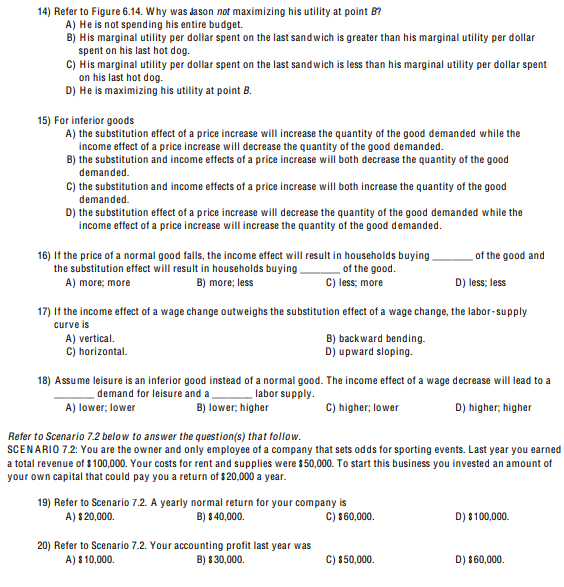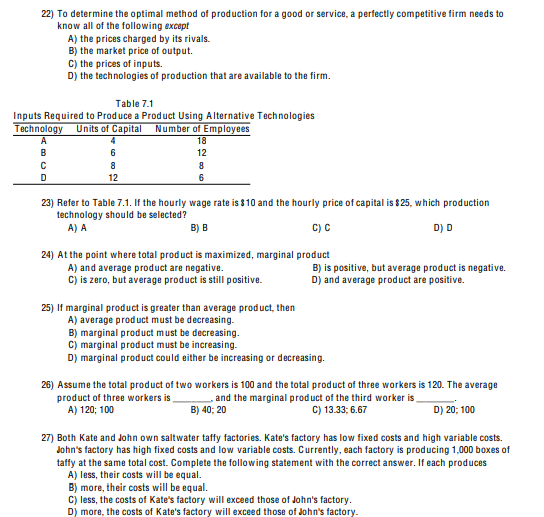can you explain how you did a question like a,b,c,d without an alternative? for those with options such as a,b,c,d , just write the answer
14) Refer to Figure 6.14. Why was Jason not maximizing his utility at point B? A) He is not spending his entire budget. B) His marginal utility per dollar spent on the last sandwich is greater than his marginal utility per dollar spent on his last hot dog. C) His marginal utility per dollar spent on the last sandwich is less than his marginal utility per dollar spent on his last hot dog. D) He is maximizing his utility at point B. 15) For inferior goods A) the substitution effect of a price increase will increase the quantity of the good demanded while the Income effect of a price increase will decrease the quantity of the good demanded. B) the substitution and income effects of a price increase will both decrease the quantity of the good demanded. C) the substitution and income effects of a price increase will both increase the quantity of the good demanded D) the substitution effect of a price increase will decrease the quantity of the good demanded while the Income effect of a price increase will increase the quantity of the good demanded. 16) If the price of a normal good falls, the income effect will result in households buying of the good and the substitution effect will result in households buying of the good. A) more; more B) more; less Cj less, more D) less; less 17) If the Income effect of a wage change outweighs the substitution effect of a wage change, the labor-supply curve is A) vertical. B) backward bending- Cj horizontal. D) upward sloping. 18) Assume leisure is an inferior good instead of a normal good. The income effect of a wage decrease will lead to a demand for leisure and a labor supply. A) lower; lower B) lower; higher C) higher; lower D) higher; higher Refer to Scenario 72 below to answer the question(s) that follow. SCENARIO 7.2: You are the owner and only employee of a company that sets odds for sporting events. Last year you earned a total revenue of $100,000. Your costs for rent and supplies were $50,000. To start this business you invested an amount of your own capital that could pay you a return of $ 20,000 a year. 19) Refer to Scenario 7.2. A yearly normal return for your company is A) $ 20,000. B) $ 40,000 C) $60,000. D) $ 100,000. 20) Refer to Scenario 7.2. Your accounting profit last year was A) $ 10,000. B) $ 30,000. C) $50,000. D) $60,000.Tom's monthly budget constraint 40- A Number of hot dogs per month OD B OF C 0 20 Number of hamburgers per month Figure 6.1 2) Refer to Figure 6.1. Assume Tom's budget constraint is AC. If the price of a hamburger is $10, the price of a hot dog is A) $4. B) $5. C) $10. D) $ 20. 3) Refer to Figure 6.1. Along budget constraint AC, the opportunity cost of one hamburger Al la 1/4 of a hot dog- B) is 1/2 of a hot dog. C) is 2 hot dogs. D) changes as you move down along the budget constraint. 4) Michael can buy either pizzas or submarine sandwiches. If the prices of pizzas and submarine sandwiches fall by half and so does Michael's money income, we can conclude that Michael's budget constraint will A) remain unchanged. B) swivel in so that the slope of the budget constraint is doubled. C) shift in but remain parallel to the old one. D) shift out but remain parallel to the old one.36) Corn is produced in a perfectly competitive market. The demand for corn increases. This will cause the Individual corn farmer's marginal revenue to and their profit-maximizing level of output to A) increase; decrease B) decrease; increase C) increase; Increase D) decrease; decrease Cost and demand conditions SA MC ATC AVC 15 d = MR Price per bushel 13 11 3 6 9 12 16 17 q Bushels of wheat Figure 9.1 37) Refer to Figure 9.1. This farmer's fixed costs are A) $0. B) $ 24. C) $ 45. D) indeterminate unless we know the level of output the firm is producing. 38) Refer to Figure 9.1. If this farmer maximizes profits, his average variable cost will be A) $7. B) $9. C) $11. D) $ 15. 39) Refer to Figure 9.1. This farmer will continue to produce at any price above but will not produce below that price. A) $15 B) $ 11 C) 89 D) $7 40) Billy Bob's Fertilizer Engineers, a perfectly competitive firm, is incurring a loss, but the price is still above minimum average variable cost. Then in the short run this firm should , and in the long run, if there is no change in economic conditions, this firm should A) produce where MR = MC; exit the industry B) produce where MR = MC; expand C) shut down; expand D) shut down; exit the industry 41) You are hired as an economic consultant to The Pampered Pet Shop. The Pampered Pet Shop operates in a perfectly competitive industry. This firm is currently producing at a point where market price equals its marginal cost. The market price is less than its average variable cost. You should advise the firm to A) lower its price so that it can sell more units of output. B) raise its price until it breaks even. C) cease production immediately because it is not covering its variable costs of production. D) produce in the short run to minimize its loss, but exit the industry in the long run.22) To determine the optimal method of production for a good or service, a perfectly competitive firm needs to know all of the following except A) the prices charged by its rivals. B) the market price of output. C) the prices of inputs. D) the technologies of production that are available to the firm. Table 7.1 Inputs Required to Produce a Product Using Alternative Technologies Technology Units of Capital Number of Employees A 18 12 23) Refer to Table 7.1. If the hourly wage rate is $ 10 and the hourly price of capital is $25, which production technology should be selected? A) A BJ B CJ C DJ D 24) At the point where total product is maximized, marginal product A) and average product are negative. B) is positive, but average product is negative. C) is zero, but average product is still positive. D) and average product are positive. 25) If marginal product is greater than average product, then A) average product must be decreasing- B) marginal product must be decreasing. C) marginal product must be increasing. D) marginal product could either be increasing or decreasing. 26) Assume the total product of two workers is 100 and the total product of three workers is 120. The average product of three workers is and the marginal product of the third worker is A) 120; 100 B) 40: 20 C) 13.33: 6.67 D) 20: 100 27) Both Kate and John own saltwater taffy factories. Kate's factory has low fixed costs and high variable costs. John's factory has high fixed costs and low variable costs. Currently, each factory is producing 1,000 boxes of tally at the same total cost. Complete the following statement with the correct answer. If each produces A) less, their costs will be equal. B) more, their costs will be equal. C) less, the costs of Kate's factory will exceed those of John's factory. D) more, the costs of Kate's factory will exceed those of John's factory.42) Refer to Figure 9.2. Suppose demand for wheat is initially D2. If consumer incomes increase, then demand for wheat will shift to This will the equilibrium price of wheat, and individual profit-maximizing firms will produce bushels of wheat. A) D3; increase; 15 B) D3; decrease; 7 C) D1 : increase; 10 D) D1 ; decrease; 0 43) Refer to Figure 9.2. If demand for wheat is D , then a profit-maximizing firm will produce units and earn A) 5; zero profits B) 0; negative profits C) 12; positive profits D) 10; negative profits 44) Refer to Figure 9.2. If MR = $9, then in the long run A) the firm will shut down. B) the firm will exit the industry. C) new firms will enter the industry and the current firms will expand production. D) None of the above is correct. 45) For economies of scale, a(n) in a firm's scale of production leads to average total cost. A) decrease; no change in B) increase; higher C) decrease; lower D) increase; lower 1) Assume that in a perfectly competitive market each firm has the same cost structure. Such that in the long-run (at the optimal scale) each firm has the following average cost function AC=q2-20q+120. If total market demand is given by Q=1500-50P; a. What would be the long- run equilibrium price and equilibrium output in this market? b. How many firms would operate in the long- run? Explain your answers & show your calculations











